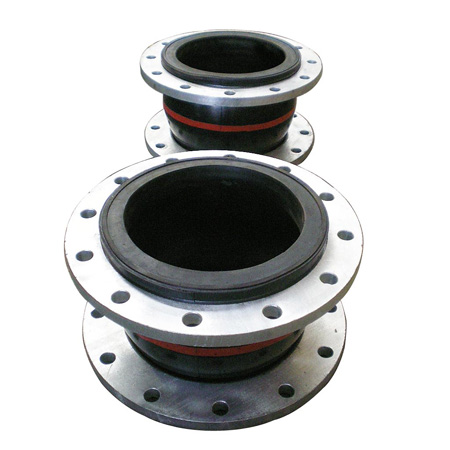Rubber Bellows Expansion Joint
| Item No.: | 8-2 CDI-700, CDI-710, CDI-730 |
Supplier Details
Country: Afghanistan
State: Taiwan
City: Kaohsiung County 831
Address: No.84, Huadong Rd., Ta Fa Industrial District, Daliao Township
TEL: +886-7-7873488
Fax: +886-7-7872755

Online Showroom:
100 Products
1. Definition:
A rubber expansion joint is used as flexible connector, fabricated of natural/synthetic rubber, and PTFE within pipe systems. It is truly muti-talented in terms of temperature, pressure and fluid resistance. If necessary, metal reinforcements provide stress relief in pipe systems because of thermal movement and vibration. Its features include and concurrent movements in either single or multiple arch type construction, isolation of vibration and noise, resistance to abrasion and chemical erosion.
Composite reinforced structure of rubber expansion joint is combined of a rubber mold and a reinforcing material; therefore, high strength to flexibility ratios can be achieved. Its material, usually a kind of fiber, provides the strength and stiffness. The rubber mold, with low strength and stiffness, provides air-fluid tightness, and supports the reinforcing materials to maintain their relative positions, affecting to the resulting mechanical properties.
2. Functions:
2.1 Reduces vibration
A rubber expansion joint isolates or reduces vibration caused by equipment.
2.2 Dampens sound transmission
A rubber expansion joint tends to dampen transmission of sound because of the steel-rubber interface of joints and mating flanges.
2.3 Compensates axial, lateral, torsional and angular movements
A rubber expansion joint compensates for lateral, torsional and angular movements – preventing damage and undue downtime of plant operations.
3. Advantages:
3.1 Vibration and sound absorption
Equipment in factories usually generates noise and vibration so this reduces efficiency in adjacent equipment and impairs working conditions in offices and factories. A rubber expansion joint insulates against destructive vibration that might causes ruptures and leaks.
3.2 Freedom from corrosion
A rubber expansion joint is manufactured to withstand corrosive chemicals, and provide protection against acid fumes and ozone attack.
3.3 Small space requirements
Flexible, light weight, rubber joints can be inserted in a minimum of space.
3.4 High resistance to shack
A rubber expansion joint withstands strong surge pressures without shattering due to its tensile strength.
3.5 Greater recovery from movement
A rubber expansion joint neither cracks nor fractures under repeated flexing. It has a remarkably long life expectancy, even under adverse conditions, because it is made only from finest grades of rubber and other materials.
3.6 Elimination of electrolysis
Rubber, a non-conducting material, makes the best expansion joints for machinery in which electrolysis can be a problem. A rubber expansion joint can isolate an electrolytic circuit.
3.7 Freedom from embrittlement
A rubber expansion joint enable to stand up to extreme higher temperature and pressure.
4. Useful rubber material comparison

A rubber expansion joint is used as flexible connector, fabricated of natural/synthetic rubber, and PTFE within pipe systems. It is truly muti-talented in terms of temperature, pressure and fluid resistance. If necessary, metal reinforcements provide stress relief in pipe systems because of thermal movement and vibration. Its features include and concurrent movements in either single or multiple arch type construction, isolation of vibration and noise, resistance to abrasion and chemical erosion.
Composite reinforced structure of rubber expansion joint is combined of a rubber mold and a reinforcing material; therefore, high strength to flexibility ratios can be achieved. Its material, usually a kind of fiber, provides the strength and stiffness. The rubber mold, with low strength and stiffness, provides air-fluid tightness, and supports the reinforcing materials to maintain their relative positions, affecting to the resulting mechanical properties.
2. Functions:
2.1 Reduces vibration
A rubber expansion joint isolates or reduces vibration caused by equipment.
2.2 Dampens sound transmission
A rubber expansion joint tends to dampen transmission of sound because of the steel-rubber interface of joints and mating flanges.
2.3 Compensates axial, lateral, torsional and angular movements
A rubber expansion joint compensates for lateral, torsional and angular movements – preventing damage and undue downtime of plant operations.
3. Advantages:
3.1 Vibration and sound absorption
Equipment in factories usually generates noise and vibration so this reduces efficiency in adjacent equipment and impairs working conditions in offices and factories. A rubber expansion joint insulates against destructive vibration that might causes ruptures and leaks.
3.2 Freedom from corrosion
A rubber expansion joint is manufactured to withstand corrosive chemicals, and provide protection against acid fumes and ozone attack.
3.3 Small space requirements
Flexible, light weight, rubber joints can be inserted in a minimum of space.
3.4 High resistance to shack
A rubber expansion joint withstands strong surge pressures without shattering due to its tensile strength.
3.5 Greater recovery from movement
A rubber expansion joint neither cracks nor fractures under repeated flexing. It has a remarkably long life expectancy, even under adverse conditions, because it is made only from finest grades of rubber and other materials.
3.6 Elimination of electrolysis
Rubber, a non-conducting material, makes the best expansion joints for machinery in which electrolysis can be a problem. A rubber expansion joint can isolate an electrolytic circuit.
3.7 Freedom from embrittlement
A rubber expansion joint enable to stand up to extreme higher temperature and pressure.
4. Useful rubber material comparison

 English
English
 中文繁體
中文繁體 Русско
Русско Deutsch
Deutsch Español
Español Português
Português Français
Français Türk
Türk Italiano
Italiano Nederlands
Nederlands हिन्दी
हिन्दी Bahasa Indonesia
Bahasa Indonesia
